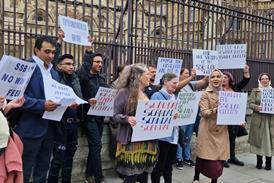The work that solicitors have done under the mineworkers’ compensation scheme has attracted the attention of press, parliament and the public ever since details of wrongdoing began to emerge earlier this decade. But the debate has focused on two controversies: the millions of pounds that solicitors have earned, and the deductions that some solicitors made from miners’ compensation.
Little has been said about the quality of legal service that solicitors provided to miners and deceased miners’ families – and whether levels of service had a real impact on the levels of compensation.
Now a key figure in the coal health debate wants the government to address precisely that issue. Labour MP David Anderson, chair of the all-party coalfield communities group, has asked David Kidney, minister for energy and climate change, whether the government will investigate the wide variations in compensation awards between firms – and whether these variations might have arisen from a failure by some solicitors to act in the best interests of clients.
Describing a recent meeting with Kidney, Anderson said: ‘I raised the question of whether any work was being done to look into the differences [in levels of compensation achieved] by different solicitors. There has been some discussion about it – it’s not as simple as some [solicitors] have worked better than others. I think there’s a genuine public interest given that this is public money. If solicitors are doing this work, then they should do the best job possible and the results would show that.’
Industry observers have pointed to apparent flaws in the compensation agreements – which are extraordinarily complex – which meant that one solicitor could in theory have provided a lower level of service to their miner clients than another solicitor, yet received equal or better payment in legal fees. Shifting a high volume of claims quickly could have proved more profitable than battling over a smaller number of claims for longer, even if fighting on would eventually yield more fees per claim.
BackgroundIt is now a decade since the government launched a scheme to compensate former miners who, because of their mining work, contracted chronic obstructive pulmonary disease (COPD), a form of lung disease that can be caused by the inhalation of coal dust, and vibration white finger (VWF), a disease of the fingers caused by vibrating mining tools. The Department of Trade and Industry and a group of miners’ solicitors drew up two special legal contracts, called claims handling agreements (CHAs), to allow thousands of miners’ claims to be handled outside the courtroom. The Union of Democratic Mineworkers drew up separate but similar agreements with the DTI. It is the biggest compensation scheme in the world.
In return for processing claims under the agreements, solicitors received fees from the DTI, but only if the claim succeeded. In theory, the agreements would ensure that miners with comparable mining-related injuries were paid similar amounts in compensation. However, figures obtained by Anderson through parliamentary questions to the Department of Energy and Climate Change (DECC) – which now handles the miners’ compensation scheme – uncovered big differences in average payments, depending on which firm was used (see tables).
Although the firms named handled the bulk of miners’ claims, hundreds of other firms have been involved since 1999.
A report by the National Audit Office (NAO) in 2007 said that the DTI had failed to properly assess and pilot the agreements. The DTI had drawn up a ‘risk register’ regarding the potential risks to the scheme, which the DECC has refused to release despite repeated requests from the Gazette.
Both schemes are now closed to new claimants. Some 590,000 COPD claims and 170,000 VWF claims have been lodged in England, Scotland and Wales. By May 2009, £2.3bn had been paid to miners and their families under the COPD scheme, and £1.7bn under the VWF scheme.
COPD The CHAs are substantial documents that have been continually updated. Among other things, they set out tariffs for the different categories of damages available to the claimant.
Claimant miners were assessed to determine the extent to which their inhalation of coal dust – rather than other factors, such as smoking – had caused them to develop COPD. They took a screening spirometry test to measure the extent of their lung damage. Miners were then assessed by a senior respiratory doctor, who produced a detailed medical report based on further lung function tests, the miner’s medical records and claim form. For dead miners, only medical records were assessed. The doctor’s final report, which noted the severity of the COPD and the miner’s smoking history, was submitted to the DTI.
The DTI could award two core categories of compensation, depending on its evaluation of the doctor’s final report: general damages, to compensate pain, suffering and loss of amenity; and special damages, to compensate financial loss caused by the disease – such as loss of earnings, benefits, redundancy package and pension, and the costs of nursing care and accommodation.
Before making an offer to the miner the DTI reduced compensation under these two categories of damages by a certain percentage. The reduction depended on the miner’s smoking history and the potency of the coal dust present in the mines he worked in. For example, the 2007 NAO report suggested that a miner working for 20 years underground, in a mine with highly potent dust, with 40 years of heavy smoking, would receive 25% of his full award of damages. This percentage figure was known as the ‘recoverable proportion’.
The final COPD compensation awards accepted by claimant miners ranged from 50p to £375,000, according to the 2007 NAO report, using figures to 31 March 2007. The median award was £1,500. Calculations based on the NAO figures show that the average solicitor’s fee was £1,920, out of the total £3,200 cost of administering a COPD claim.
The NAO observed that the COPD scheme had been ‘particularly costly to administer’. A separate government-commissioned report by Stephen Boys Smith in 2005 noted that, under its separate agreement, COPD legal fees payable to Vendside, the claims handler for the Union of Democratic Mineworkers, were approximately 83% of the fees agreed under the standard agreement, ‘on the basis that Vendside would handle most cases without the use of solicitors’.
The setup of the CHA allowed solicitors, if they chose, to accept the first offer of compensation made by the DTI without challenging the doctor’s diagnosis, and without challenging the DTI’s assessment of the doctor’s report. Professor Peter Barnes, head of respiratory medicine at Imperial College, says that, while the existence of COPD is easy to diagnose using a spirometer, it is ‘very difficult to sort out the component due to coal dust and the component due to smoking’. The 2007 NAO report pointed to the ‘difficulty of diagnosing COPD and making these judgments’.
The agreement, therefore, can hardly be said to have encouraged solicitors to challenge the recoverable proportion applied by the DTI. This would have impacted most notably on high-value awards, where a successful challenge over a few percentage points could have led to thousands of pounds more compensation.
Moreover, the financial incentives for solicitors to challenge the doctor’s or the DTI’s decisions were either paltry or non-existent. Under the original COPD agreement, solicitors were paid just £250 for successfully disputing the DTI’s damages offer – which compares poorly with the average success fee of £1,920. Under the revised COPD agreement, solicitors were paid £289 for a successful dispute. If oral mediation resulted in a favourable decision for the claimant, the solicitor was guaranteed at least the minimum dispute payment (£250). They received nothing for an unsuccessful dispute.
This provided solicitors with an apparent financial disincentive to dispute a case: if they failed, they gained nothing; if they succeeded, they would have had to wait for the dispute to be resolved before receiving a marginal fee. A big success fee was still available whether or not the miner’s claim was pursued to the full.
Fast-tracking Special procedures were available to speed up COPD claims: expedited payments, and later on, fast-track payments. They allowed the claimant miner to receive an award based on screening spirometry alone, and skip the full medical assessment. However, these awards were lower than those following a full medical assessment.
Expedited payments were available from the start of the scheme. According to the 2007 NAO report, 24,000 claims were settled using this route. In 2005, new fast-track procedures were introduced to deal with a logjam of claims. The dead optional risk offer scheme (DOROS), an opt-in scheme, compensated the families or estates of deceased miners if COPD was mentioned on the miners’ death certificate. The live optional risk offer scheme (LOROS), an opt-out scheme, presented living claimants with an automatic offer of £1,400, £3,700 or £12,900.
But all the fast-track routes were optional. Claimants could choose to take the full medical exam from the outset or, if they didn’t like a compulsory fast-track offer, take the full medical assessment to try and win more compensation.
This evaluation was left in the hands of the miner’s solicitor, yet fast-tracking gave solicitors an incentive to settle a claim early. By recommending that the miner choose the fast-track procedure – even if more compensation could be won following full medical assessment – the solicitor would receive a reduced fee, but they would receive their fee much quicker.
Solicitors were paid well for successful claims under the fast-track routes. Average solicitor costs under the LOROS and DOROS fast-track schemes were initially £1,815, although the DTI later succeeded in reducing them. Nevertheless, for LOROS fast-track claims, solicitors received a minimum of £1,100, and for DOROS claims, at least £1,190. With expedited payment to living miners, solicitors received a minimum guaranteed success fee of between £900 and £1,041. Considering there was far less work to do, these sums compared favourably with the average £1,920 fee for a COPD claim. The conveyor-belt nature of the claims handling work meant that, because of inherent flaws in these processes, solicitors could earn more money by directing a high volume of claims down the fast-track routes, rather than fighting to secure the best compensation for each miner by heading down the full medical assessment route.
Two official reports show that fast-track LOROS claims were accepted at a far higher rate than anticipated. Acceptance of LOROS offers by claimants had been expected to be 60%, but by 31 March 2007, 96% of the 75,000 LOROS offers made by the DTI had been accepted.
Vibration white finger Medical assessment of VWF was complicated, but followed the pattern of the COPD assessment. A medical technician carried out a number of tests, then a final report was written up by a specialist doctor. However, some VWF damages categories were not available from the outset of the scheme, which complicated the compensation arrangements.
Initially, if mining-related VWF was diagnosed, two categories of compensation could be awarded: general damages, and Smith v Manchester damages for any handicap that the miner suffered in their post-mining working life. Solicitors could claim for two further categories of damages, although offers under these categories were only made from 2003 – loss of earnings, and services damages for the costs of assistance with everyday tasks. Expedited and fast-track payments were never introduced for VWF claims.
Awards under the general damages category ranged from £1,000 to £18,000, rising with inflation to between £1,154 and £21,212. Smith v Manchester awards initially ranged from £1,500 to £10,000, which later changed to between £1,734 and £8,664.
Special tariffs were agreed for loss of earnings damages and for services damages. For services damages, eligible miners were awarded between £530 and £1,000 a year, rising with inflation to between £612 and £1,155 a year. These sums were multiplied by the number of years that the miner needed help with everyday tasks – which meant that services damages soon emerged as one of the more lucrative damages categories. As the 2005 Boys Smith report observed, ‘services claims, originally expected to be a minor part of the VWF compensation package, deliver much larger payments than could be obtained if the cases had been taken to court individually’.
The final VWF compensation awards that were accepted by miners ranged from £68 to £120,000, according to the 2007 NAO report, using figures to 31 March 2007. The median award was £8,300. Calculations based on the NAO figures show that the average solicitors’ fee was £884, out of the total £2,600 cost of administering a VWF claim. The 2005 Boys Smith report noted that under its separate agreement, VWF legal fees payable to Vendside, the claims handler for the Union of Democratic Mineworkers, were either equal to or lower than the corresponding costs under the standard agreement.
The VWF scheme shared similar problems with the COPD scheme, in that challenges to the doctor’s or DTI’s decisions depended almost entirely on the solicitor. In fact, solicitors were paid even less for raising disputes in VWF cases: £200, rising with inflation to £217. Worse, if they raised more than one dispute, their total dispute fee was capped at £300 (rising to £346).
In some cases, solicitors failed to challenge the DTI’s misclassification of the miner’s occupational group – for example, whether they worked as a face fitter, where vibrating tools were commonly used, or as a crane driver, where they were not. This resulted in rejected claims or reduced awards being granted. DTI figures from 2006 show that it was possible for solicitors to successfully challenge the DTI’s occupational group classification, but that the willingness of solicitors to challenge the DTI seemingly varied between firms.
| Firm | Avg VWF settlement (£) |
|---|---|
| Watson Burton | 17, 106 |
| Thompsons Solicitors | 16, 379 |
| Graysons Solicitors | 15, 537 |
| Towells Solicitors | 12, 468 |
| Raleys Solicitors | 12, 405 |
| Hugh James | 11, 319 |
| Browell Smith and Co | 10, 854 |
| Union of Democratic Mineworkers | 10, 607 |
| Moss Solicitors | 10, 514 |
| Beresfords Solicitors | 10, 399 |
| Firm | Avg COPD settlement (£) |
|---|---|
| Thompsons Solicitors | 9, 202 |
| Mark Gilbert Morse | 7, 535 |
| Hugh James | 7, 261 |
| Browell Smith and Co | 6, 538 |
| Raleys Solicitors | 5, 990 |
| Watson Burton | 4, 346 |
| Union of Democratic Mineworkers | 3, 097 |
| Barber and Co | 2, 832 |
| Beresfords | 2, 559 |
| Avalon Solicitors | 2, 375 |
Money now vs money later There were other problem areas. Once an award under the general damages category was accepted, the miner’s claim was closed, and he was unable to make a further claim under the other categories. The claims handling agreement did not force solicitors to wait to assess whether clients would be eligible for loss of earnings and services damages. Solicitors who have handled negligence cases stemming from the scheme told the Gazette that some solicitors simply failed to apply for Smith v Manchester damages at the same time as they applied for general damages. The miner would then, without knowing, accept an award of general damages alone, barring him from any future Smith v Manchester claim. Submitting a claim for Smith v Manchester damages was generally very easy – if eligible miners were in work and could supply a payslip to the DTI as proof, they would receive an award.
The problem was exacerbated by the fact that loss of earnings and services damages were not immediately available. To ensure an eligible miner received awards for loss of earnings and services, solicitors had to reject general damages and Smith v Manchester damages until the other two categories came into force. The Gazette has seen evidence of a number of settled negligence cases against solicitors who failed to reject general damages and Smith v Manchester damages, denying an eligible claimant loss of earnings and services damages.
But even more striking information has come to light concerning the potentially lucrative services damages category. Unpublished DTI statistics circulated to solicitors and obtained by the Gazette show that, when the VWF scheme closed, 109,000 of the 170,000 miners claiming for VWF damages were eligible for services damages awards – yet services damages claims were lodged for just 59,000 claimants. In other words, it can be argued that 50,000 miners did not receive the compensation they were owed by the government for the difficulties they faced in carrying out day-to-day tasks because of their mining injuries. Because services damages were often high, failure to claim for them could cause the biggest hole in the miner’s final award.
Interim payments were available for both COPD and VWF claims, giving the miner access to some of his compensation while, in theory, his solicitor battled with the DTI to boost the final award. For example, with an interim VWF payment, the miner would be paid upwards of 80% of the DTI’s offer against his disputed damages claim. A solicitor would be paid around £500 if the miner accepted the interim payment, but would only be paid the remainder of their fee upon resolution. For COPD claims, solicitors’ fees were likely to be even less.
Given the nature of his constituency, Anderson can hardly be faulted for voicing his concerns and trying to get to the bottom of what explains these – on the face of it glaring – anomalies. To his credit he accepts there may be perfectly valid explanations unrelated to service levels; the sheer complexity and deeply flawed nature of the schemes themselves surely explains much. Certainly, many of those firms that handled most claims, all of whom were asked to comment on the concerns raised by Anderson, are adamant that they acted in clients’ best interests (see box).
What is clear is that the DECC holds enough data to launch a fully fledged inquiry into the compensation awards. Whether the government will do so surely depends on the preliminary investigation Kidney has set in train.
What the firms say
Beresfords: COPD rank 9, VWF rank 10. ‘We always endeavour to act in the best interests of our clients. The type of clients that we attracted and how they were compensated under the scheme is the main reason for any variations in compensation. The damages awarded to miners are based on a fixed tariff set out under the relevant schemes. Medicals carried out to ascertain the severity of the condition were also carried out as part of the schemes. Beresfords solicitors did not create or influence the schemes but acted for miners under the terms of it and as such had no direct control over the level of damages awarded.
‘Beresfords solicitors has successfully helped many thousands of clients, although most of these were late in coming to the scheme and did so as a response to the high-profile advertising campaigns carried out. Beresfords, through high-profile advertising, including television, brought the scheme to younger miners and families of deceased miners who would not otherwise have put forward a claim. This created a different portfolio of clients to most other firms. Those miners who were still living with more chronic conditions, that would have attracted much larger settlements, would have been more likely to have been already registered under the scheme before the high-profile advertising. This would have had a significant impact on average settlement fees.’ Spokesperson
Browell Smith and Co: COPD rank 4, VWF rank 7. ‘The tables referred to represent the levels of compensation achieved against DECC (formerly DTI). The position in the table reflects the average compensation received from DECC but does not reflect all the variables that may come into play in settlement or, so I am led to understand, compensation received on claimants’ cases from other insurers which may have led to an apportionment of damages.
‘In relation to chest injury specifically, you will be aware of the variability caused by the level of injury as a result of the greater level of dust in South Wales and to the effect on compensation where the solicitor has dealt with a majority of cases where their client has been a widow of the deceased mineworker and where the level of settlement would reflect the size of bereavement damages awards made.
‘Do not think that our positioning reflects any failure to act in the best interests of our miner clients. Indeed, we have pursued many cases both within vibration white finger and COPD litigation that have subsequently been brought to a successful conclusion when they might otherwise have been rejected.’ Philip Browell, partner
Raleys: COPD rank 5, VWF rank 5. ‘From the outset of the coal health compensation scheme, Raleys made a very public commitment to the mining communities we have served for more than 100 years that we would pursue every case that had the remotest chance of success, against every defendant that could be liable, within or outside the scheme, and that we would pursue all claims, large or small, with equal vigour in order to achieve the best result we could for each miner or their family, with little regard to difficulty involved or the time or cost incurred by Raleys.
‘The facts that we handled more than 60,000 cases, remained faithful to our promise to pursue even the hardest-to-win cases, successfully took on claims that other law firms dismissed as no-hopers, won claims that were initially denied, and yet still managed to appear in the middle of these simplistic tables of the most active law firms is a tribute to the extraordinary commitment, skills and persistence of our legal teams.’ Carol Gill, managing partner
Hugh James: COPD rank 3, VWF rank 6. ‘As a firm we are very proud of having acted not just in the schemes but in the test cases which led to the judgments which in turn triggered the schemes. I am entirely satisfied that there has been no failure on our part to act in our clients’ best interests. Indeed, the contrary is the case.
‘There are a host of good reasons why compensation figures vary – often significantly – from case to case. The age of the claimant and the extent of the disability are, for example, significant factors. That is why there is no standard settlement figure either in the VWF or the COPD cases. The question is whether clients have been properly compensated having regard to all the factors relevant to their individual circumstances.’ Gareth Williams, senior partner
Towells: VWF rank 4. ‘In terms of compensation awarded to clients, Towells was ranked fourth out of 10. That puts five major firms of solicitors and one trade union (the UDM) below Towells in terms of compensation recovered. Your questions [pertaining to alleged] "failure" should, therefore [not be addressed to Towells].
‘Towells pursued every single claim exhaustively and with great expertise, thereby recovering the maximum award of compensation to which each client was entitled under the claims handling agreement, British Coal vibration white finger litigation.’ David Russell, partner
Watson Burton: COPD rank 6, VWF rank 1. ‘There are between 50 and 60 law firms handling COPD claims and VWF claims. We were placed first out of the top 10 because we obtained the best awards for our client. This does not necessarily mean that other firms did a less competent job, but rather that the particular clients who we were instructed by were entitled to high awards. Similarly, being placed sixth out of 50 or 60 firms demonstrates not only competence but also the particular circumstances of the clients who instructed us.’ Richard Palmer, partner
Graysons: VWF rank 3. ‘Achieving the third-highest average compensation settlement for miners affected by vibration white finger gives a strong indication of just how hard we worked for our clients. We acted in their best interests at all times.’ Spokesperson
Thompsons: COPD rank 1, VWF rank 2. ‘One large case could, for a firm running only a few cases, enormously affect their average. We ran thousands of miners’ scheme cases so our results cannot be dismissed as a statistical aberration. Any firm that ran a significant caseload of scheme cases could have achieved similar results.
‘We have always strived at Thompsons to achieve the maximum compensation available for our clients in all our cases. It has been hugely gratifying to see a reflection in these tables of the efforts made on behalf of former miners and their families referred to us through their union. They are results of which we are proud.’ Tom Jones, head of policy and public affairs
- Declined to comment: Avalon & Co; Moss Solicitors; Barber and Co; Union of Democratic Mineworkers/Vendside
- Did not respond to requests for comment: Mark Gilbert Morse



























No comments yet